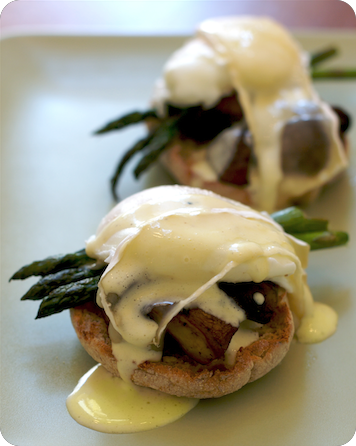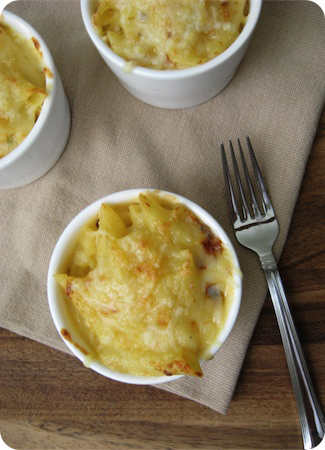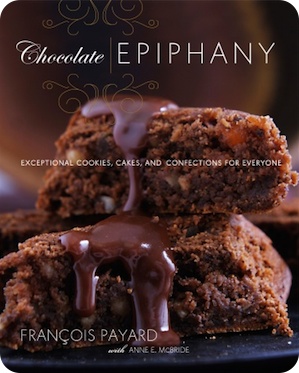Kitchen aid; reviewing In the Kitchen with Anna by Anna Olson
 Monday, November 24, 2008 at 1:27PM
Monday, November 24, 2008 at 1:27PM 
These Chocolate Almond Toffee Bars look innocent enough, but are two bites of true, gooey indulgence. Photos courtesy of Deep Media.
Even though one may not mean to become caught up in things, sometimes it is unavoidable. Such was my case recently, as a (thankfully-mild) strain of the chicken pox made its way through our little ones, forcing our household into a state of quarantine and oatmeal baths for two weeks. This was followed closely by an infection that had Mummy curled up on the couch, slippers on and blanket pulled up tight, for another few days. Suddenly almost a month has gone by, and it seems all in a blur.
Now we are about ankle-deep in holiday preparations; events with family and friends are already scheduled, decorations are already being considered, and menu ideas are already floating around in my head. Where did this autumn go? It feels like Halloween was just yesterday.
Lucky for us, I had the book In the Kitchen with Anna: New ways with the Classics standing by at the ready. In it, chef Anna Olson offers up meals and menus that have a nostalgic appeal; a bit retro, a bit kitch sometimes, but always tasty. This is feel-good eating at its best, and just the sort of food one craves when life gets a bit hectic.
While the book does include entertaining-worthy recipes like unctuous Mushroom Potato Brie Tarts and an impressive Garlic Roasted Turkey Crown with Chardonnay Pan Sauce, it is the modern classics like the Contemporary Cobb Salad, Ultimate Cheese Fondue and Baja Fish Tacos, that are, in my mind, the real draw.
Through the craziness over the last few weeks, I found myself turning to this book numerous times for inspiration. And rarely did it disappoint.
I have pledged my allegiance to steel-cut oats, but I tried Olson's version using the rolled variety when I found my cupboard was bare of the former. Surprisingly light due to the addition of oat bran, the oatmeal was delicious. So good in fact, that when mornings dawned cold and grey, I reached for this breakfast again and again.
The Rockwell Bake, a savoury bread pudding that combines all the flavours of Thanksgiving dinner, was hearty and soul-satisfying. Anna's Pot Roast was fairly-standard comfort fare, brightened through a second addition of vegetables towards the end of cooking. While good, however, what stole the show that night was the recommended accompaniment of Fluffy Dumplings. True to their title, these dumplings were pillowy-light, and an ideal way to sop up the roast's beer-soused gravy.
For those visiting the Niagara Region, Olson's two specialty food shops sell dishes from In the Kitchen with Anna as some of their prepared foods. It is a wonderful opportunity to taste some of the food before purchasing the book and also a testament to Olson's confidence in standing behind these recipes - a true mark of quality.
It was at her St. David's, Ontario, location that we were able to try the Beef, Caramelized Onion and Smoked Cheddar on Foccacia sandwich. Hot off of the panini press, the exterior was shatteringly crisp, giving way to melt-in-your-mouth slices of beef, accented by sweet onions, a slathering of grainy mustard and subtly-smoked cheese.
Since Olson is famous for her desserts, far be it from me to ignore that chapter. The Lemon Cheesecake Mousse tarts had an beautifully light texture with the perfect sharp citrus note. They managed to be delicate but luscious, all at once. Dangerously-easy to make are the Chocolate Almond Toffee Bars (photographed above, please see recipe below); to call these rich would be a gross understatement. A sturdy crust of oats and graham is scattered with both toffee and chocolate, then almonds, and finally a blanketing of sweet condensed milk. This modest effort results in a bar cookie that is tender in its belly, but slightly burnished and crisp above. Ridiculously addicting stuff.
Only one recipe fell short of expectation; the Artichoke Asiago Squares. The appetizer, somewhat akin to crustless quiche, is billed to taste like the popular dip of the same name and readers are urged "if there is no other recipe you make from this book, please make it this one." With such an introduction, these were a definite must-try. But while the squares are good, none of my tasters thought them great. The consensus was that they were best served warm, but even then the texture was not a favourite and some found the asiago could have been more pronounced. I would not call this a failure, but I would say that there are stronger dishes in the book.
The book itself is bright and colourful. The food looks fresh, shot simply, but beautifully, by Ryan Szulc. Minimally styled by Olson, the images are homey and inviting, with little fuss marring our look at the the food.
I particularly enjoyed how the recipes were laid out. Accompanying each was not only general notes included in the header, but also a three-part footnote outlining the taste, technique and tale of that particular dish. This additional information included more in-depth information about the ingredients or preparation, and also were a peek into the personality of Olson herself; the chatty, convivial tone was charming to read.
From the every day to almost every celebration, for lazy weekends and when the weekdays are flying by, In the Kitchen with Anna: New Way with the Classics includes recipes that are excellent additions to any cook's repertoire. Showing us easy, accessible cooking with touches that make each dish feel special, Olson makes a lovely kitchen companion.

Chocolate almond toffee bars
This recipe is one of my most requested, so I'm happy to include it in this book.
Ingredients
1 1/2 cups (375 ml) rolled oats
1/2 cup (125 ml) graham cracker crumbs
1/4 tsp (1 ml) fine salt
1/2 cup (125 ml) unsalted butter, melted
1 cup (250 ml) Skor toffee bits
1 cup (250 ml) chocolate chips
1 cup (250 ml) sliced almonds
1 can sweetened condensed milk
Preheat the oven to 350°F (180°C). Grease and line an 8-inch (2 L) square pan with parchment paper so that the paper hangs over the sides of the pan.
Stir the oats, graham crumbs and salt in a bowl to combine, then stir in the melted butter. Press the crumbly oat mixture into the prepared pan. Sprinkle Skor bits evenly on top, followed by chocolate chips and sliced almonds. Pour condensed milk evenly over pan (it will sink in as it bakes) and bake for 30 to 40 minutes, or until the top is golden brown and the edges are bubbling. Cool to room temperature in the pan, then chill for at least 4 hours before slicing into bars.
Store toffee bars in the refrigerator for up to a week.
Makes one 8"x8" pan.
Taste
This is decadence in a pan. The sinful combination of chocolate, toffee and almonds enveloped in condensed milk that caramelizes as it bakes is irresistible. At least these have oats in them to redeem themselves, just a little bit.
Technique
This is a simple recipe to execute—you gather the ingredients and layer them, basically. The challenge is in waiting for them after they've finished baking!
Tale
My head pastry chef at Olson Foods + Bakery, Andrea, brought this recipe to my attention. She is an excellent baker, and we go way back. She started with me as a high school co-op student, while I was just picking up professional baking myself on the job, so we learned together. That was about 15 years ago, and after her stint at cooking school and gaining other work experience, I'm thrilled that we are working together again after all these years.
Additional recipes from In the Kitchen with Anna: New ways with the Classics
• Huevos Rancheros
• Pot Roast with Dumplings
• Luncheon Sandwich Torte

Permission to print recipe and cover image courtesy Whitecap Books.


























